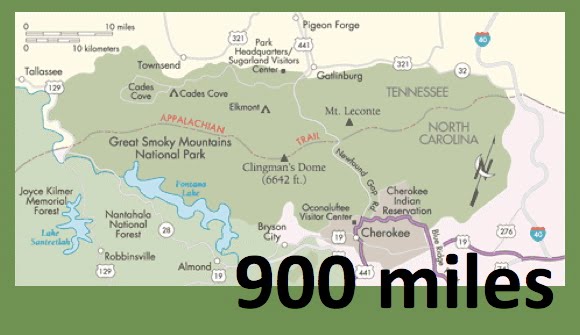Total Miles Hiked: ~ 35
7-9 June 2013
Thirteen years ago I hiked the western portion of the Appalachian Trail through the Smokies, from Newfound Gap down to Fontana Dam. It was the first big backpacking trip I did after we moved to Tennessee and I did it solo. I was relatively ill-prepared and inexperienced then, and I'm sure I carried WAY too much in my pack, but it was a great trip nonetheless. This past weekend I finally got to finish off the AT in the Smokies by doing the eastern section: from Newfound Gap to Davenport Gap. This time I went with my hiking buddy Shane, and I was a lot better prepared and more experienced. It was a fantastic trip!
trailhead at Newfound Gap
Shane's wife Sarah was kind enough to get up early and shuttle us up to Newfound Gap Friday morning. It was drizzly, and the top of the mountains were socked in with fog. I love the trail sign at Newfound Gap: "Katahdin Maine 1972.0" I can imagine that's a little overwhelming to the AT thru-hikers who make it to this point.
In general the AT through the GSMNP follows the TN/NC border and the spine of the tallest mountains in the park. Our starting point at Newfound Gap is over 5,000 ft in elevation and the bulk of the trail meanders up and down between 5,000 - 6,400 feet.
Day 1: Newfound Gap to Pecks Corner shelter. 10.8 miles
The first day out we went nearly 11 miles. Along the way we went up and over three peaks and passed both the Icewater Spring shelter and Charlies Bunion.
 |
| Icewater Spring shelter |
 |
| Sand Myrtle in flower at Charlies Bunion |
 |
| Charlies Bunion |
I should point out that there are MANY trails that intersect the AT along its length in the GSMNP. For the sake of brevity I will not mention or post pictures of all of the trail junctions like I usually do, but there are lots of ways to get up to the AT from the lower regions of the park.
Early in the afternoon I mentioned that I was getting hungry and that we should look for a place to stop for lunch. Shane agreed, and not 2 minutes later we came around a corner of the trail to find a long block of rock at the edge of the trail with amazing views down into North Carolina. The sun had come out and we basked as we ate and drank in the views.
 |
| view from the AT down into North Carolina |
 |
| Pecks Corner shelter |
Day 2: Pecks Corner shelter to Cosby Knob shelter. 13.3 miles
 |
| up and ready to hit the trail the morning of day 2 at Pecks Corner shelter |
 |
| early morning mist rising from a mountain valley |
 |
| Tricorner Knob shelter |
 |
| piece of twisted metal from the plane wreck |
 |
| rake and axe handles from the S.W.E.A.T. crew leaning against the trail sign |
Late afternoon we made it in to the Cosby Knob shelter for the night. Shane and I had stayed here with some of our Boy Scouts back in February when there was quite a bit of snow and temperatures in the single digits.
 |
| Cosby Knob shelter |
Day 3: Cosby Knob shelter to Davenport Gap and I-40. 11.2 miles
Sunday morning we actually covered 0.8 miles of trail that we had hiked back in February, from Cosby Knob shelter down to Low Gap. And from Low Gap, back up fairly steeply to the ridge of Mt. Cammerer. One of the things I was really looking forward to on this trip was a visit to the Mt. Cammerer fire lookout. I'd seen pictures, but never had the chance to visit before. It was a beautiful structure, on a beautiful site, with beautiful views! Absolutely amazing!
 |
| Mt. Cammerer fire lookout |
 |
| me at the Mt. Cammerer lookout |
 |
| view from Mt. Cammerer lookout |
From the top of Mt. Cammerer the AT drops rapidly from nearly 5,000 feet elevation down to about 2,000 feet at Davenport Gap over a distance of about 5 miles. It was like dropping through time as well - plants that were still in bud up top were out in full flower the further down we got, and we started to see species that occur at lower elevations that we hadn't seen up high. The temperature and humidity also seemed to increase steadily as we descended.
About a mile from Davenport Gap and the park boundary is a short side trail to the Davenport Gap shelter.
 |
| Davenport Gap shelter |
 |
| Shane at the park boundary in Davenport Gap |
 |
| AT marker at the trail entrance near I-40 |
I plan for this to NOT be my last backpacking trip this summer. Definitely want to get a few more trails knocked out, so stay tuned for more.
Til next time, happy hiking!









































